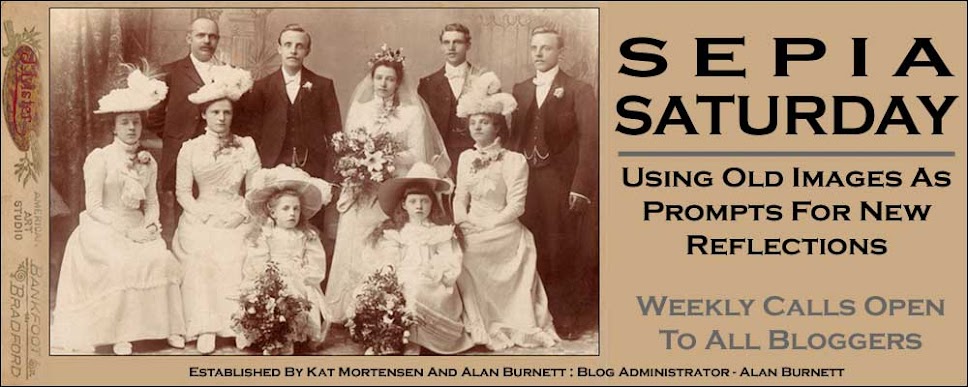
I'm posting at Sepia Saturday today. This week's challenge:

When I previewed this Sepia theme image a few weeks ago I suggested "floods, water, weather, floating cars and sepia skies" as possible interpretations. Looking back at this list now, I have to say that I, for one, am heartily sick of the first four on the list and I suspect the last suggestion is somewhat inaccurate. Those aren't sepia skies they are a kind of faded pink skies. But here at Sepia Saturday there is no such thing as a mistake, merely a new potential interpretation. So you can add to the list strange tints and colours in old photographs. I chose this particular photograph for a theme because it comes from a new contributor to Flickr Commons - the Provincial Archives of Alberta, Canada. Lovers of old photographs everywhere should celebrate every time museums, archives and galleries add their digitised image collection to Flickr for the free enjoyment of everyone rather that burying them within a barbed-wire corset of copyright laws. The photograph shows a barge moving cars to dry land during the waterways floods of 1936. Whatever your interpretation of the image all you have to do is to post a post on or around Saturday 29 March 2014 and then link to the list below.
1954 - Hurricane Hazel hits Toronto.
On Oct. 15, 1954, the most famous hurricane in Canadian history struck Southern Ontario. Hurricane Hazel pounded the city of Toronto with 110 km/hr winds and more than 200 millimetres of rain in less than 24 hours. Bridges and streets were washed out, homes and trailers were washed into Lake Ontario. Thousands were left homeless, and 81 were killed – 35 of them on one street alone.


What a devastating hurricane! I remember when I was younger, my parents made reference to this hurricane!
ReplyDeleteI never would have thought of a hurricane striking as far north as Toronto, but obviously from the photo, one did . . . & with so much damage and loss of life!
ReplyDeleteI was eight years old and living in Portland, Maine when Hazel arrived. And then there was Carol. It is amazing how much damage storms can do, isn't it?
ReplyDeleteI didn't think hurricanes struck that far north or that far from the ocean.
ReplyDeleteWhat a wonderfully atmospheric photograph. It is enough to make me wrap up warm and keep dry on this Spring day.
ReplyDeleteAnd now these days we get the radar screen on the computer and watch the bad weather approaching. Which is better I suppose as I find that visual makes quite an impact. The poor home owners in your photo.
ReplyDeleteI googled after reading this to find out more, and I see that the street that copped the most damage was converted into a park like the area Gail (Nightingale) mentioned in her blog post. What an amazing event.
ReplyDeleteAnother raging torrent. Those two vehicles are lucky to be still parked in front of the houses, I'd say.
ReplyDeleteWe quite often get 200 mm rain in a weekend but thankfully not with those winds.
ReplyDeleteI was too young to remember Hurricane Hazel, but as a kid every time hurricane season rolled around, Hazel came up in the community memories and weather reports.
ReplyDeleteWe've had many cyclones as we call them in Australia but one that still stands out in terms of ferocity and destructive effect is Cyclone Tracy, which hit Darwin on Christmas Even 1974. Wind rather than flood did the damage there. It must be unfortunate for people who just happen to be named Hazel or Tracy for example!
ReplyDeleteWhat an incredible photo!
ReplyDeleteWe humans love to think we're always in control. Not so much. Nature has a way of hitting us upside the head and saying, "Now now smarty pants."
ReplyDelete